Chemical Characteristics of Ore-Bearing Intrusions and the Origin of PGE–Cu–Ni Mineralization in the Norilsk Area
Abstract
:1. Introduction
2. Geological Background
3. Materials and Methods
3.1. Analytical Methods
3.1.1. Sample Preparation
3.1.2. Instrumental Analysis
3.2. Statistical Methods
4. Results
4.1. Geological Characteristics of the Studied Intrusions
4.1.1. The Kharaelakh Intrusion
4.1.2. The Pyasinsky-Vologochansky Intrusion
4.1.3. The Norilsk 2 Intrusion
4.2. Chemical Composition of the Rocks
4.2.1. Major Elements
4.2.2. Trace Elements
4.3. Chemical Composition of the Ores
4.4. Statistical Treatment of the Geochemical Data
5. Discussion and Conclusions
5.1. Problems of the Origin of the Norilsk Deposits
5.2. Geochemical Comparison of Intrusions with Varying Mineralization
5.2.1. Distribution of the Major Components in the Rocks
5.2.2. Behavior of the Trace Elements in the Rocks
5.3. Problem of Host-Rock Assimilation by Magma
5.3.1. Intrusion Compositions and Contact Zones: The Rapid Crystallization of Magmas
5.3.2. Anhydrite Assimilation
S Isotopic Data
Ca Balance
Deep-Zone Assimilation
Anhydrite Origin in Igneous Rocks
5.3.3. Gas Assimilation
5.3.4. Coal Assimilation
5.4. Genetic Interpretation of the Results
6. Conclusions
- The geochemical characteristics of the rocks and related ores for three intrusions of the Norilsk region were studied using XRF, ICP-MS, ICP-AES, FAAS methods. They are the Kharayelakh intrusion with a unique PGE–Cu–Ni Oktyabr’ sky deposit, the Pyasino-Vologochansky intrusion with a large Vologochansky deposit, and the Norilsk 2 intrusion with subeconomic mineralization. The similarity of the rock compositions from these intrusions, independent of their mineralization, was established.
- The rock compositions and volume mineralization of the studied intrusions do not depend on their setting in the cross section. The Kharaelakh and Pyasinsky-Vologochansky intrusions are located in the same Devonian carbonate–terrigenous rocks on the boundary of the Kurejsky and Razvedochninsky formations, but their metal resources differ by two orders of magnitude. The assimilation of the host rocks by parental magmas occurs in the narrow contact zones (with a thickness of the first meters) of the intrusive bodies, and does not affect the weighted average composition of the intrusions or the volume of mineralization.
- The lack of correlation between the silicate rock compositions and their mineralization indicates that the magmas were mostly transported agents for sulfides from the deep zones of the Earth to the surface.
Supplementary Materials
Author Contributions
Funding
Data Availability Statement
Acknowledgments
Conflicts of Interest
References
- Zavaritsky, A.N. Classification of magmatic ore deposits. Econ. Geol. 1927, 22, 678–686. [Google Scholar] [CrossRef]
- Godlevsky, M.N. Cooper-Nickel World Deposits and Problems of Their Genesis; TSNIGRI: Moscow, Russia, 1963; 22p. [Google Scholar]
- Godlevsky, M.N. Magmatic Deposits: Genesis of Endogenic ore Deposits; Nedra: Moscow, Russia, 1968; pp. 7–83. [Google Scholar]
- Naldrett, A.J. Nickel sulfide deposits: Classification, composition, genesis. Econ. Geol. 1981, 75, 628–685. [Google Scholar]
- Naldrett, A.J. A model for the Ni–Cu–PGE ores of the Norilsk region and its application to other areas of flood basalts. Econ. Geol. 1992, 87, 1945–1962. [Google Scholar] [CrossRef]
- Naldrett, A.J. Magmatic sulfide deposits: Key factors in their genesis. Miner. Depos. 1999, 34, 227–240. [Google Scholar] [CrossRef]
- Naldrett, A.J. Magmatic Sulfide Deposits: Geology, Geochemistry and Exploration; Springer: Heidelberg, Germany, 2004; 727p. [Google Scholar]
- Naldrett, A.J. Fundamentals of Magmatic Sulfide Deposits. Rev. Econ. Geol. 2011, 17, 1–50. [Google Scholar]
- Zotov, I.A. Transmagmatic Fluids in Magmatism and Ore-Forming Processes; Nauka: Moscow, Russia, 1989. [Google Scholar]
- Zolotukhin, V.V. Sulfide Cu–Ni formation, its position among other ore formations and genesis. Russ. Geol. Gephys. 1991, 27–36. [Google Scholar]
- Arndt, N.T.; Lesher, C.M.; Czamanske, G. K Mantle-derived magmas and magmatic Ni-Cu-(PGE) deposits. Econ. Geol. 2005, 100, 5–24. [Google Scholar]
- Barnes, S.-J.; Lightfoot, P.C. Formation of magmatic nickel-sulfide ore deposits and processes affecting their copper and platinum-group element contents. Econ. Geol. 2005, 100, 179–213. [Google Scholar]
- Likhachev, A.P. Platinum–Copper–Nickel and Platinum Deposits; Eslan: Moscow, Russia, 2006; 496p. [Google Scholar]
- Li, C.; Ripley, E.M.; Naldrett, A.J. A new genetic model for the giant Ni–Cu–PGE sulfide deposits associated with the Siberian flood basalts. Econ. Geol. 2009, 104, 291–301. [Google Scholar] [CrossRef]
- Li, C.; Ripley, E.M. Magmatic Ni-Cu and PGE Deposits: Geology, Geochemistry, and Genesis. Rev. Econ. Geol. 2011, 17. Available online: https://www.segweb.org/store_info/REV/REV-17-Additional-Product-Info.pdf (accessed on 27 July 2021).
- Lightfoot, P.C. Advances in Cu–Ni-PGE sulfide deposit models and implications for exploration technologies. Ore Depos. Explor. Technol. 2014, 44, 629–646. [Google Scholar]
- Malitch, K.N.; Belousova, E.A.; Griffin, W.L.; Badanina, I.Y.; Latypov, R.M.; Sluzhenikin, S.F. Chapter 7. New insights on the origin of ultramafic-mafic intrusions and associated Ni–Cu–PGE sulfide deposits of the Norilsk and Taimyr provinces, Russia: Evidence from radiogenic and stable isotope data. In Processes and Ore Deposits of Ultramafic-Mafic Magmas through Space and Time; Elsevier: Chennai, India, 2018; pp. 197–238. [Google Scholar]
- Barnes, S.-J.; Le Vaillant, M.; Godel, B.; Lesher, M. Droplets and bubbles: Solidification of sulfide-rich vapor-saturated orthocumulates in the Norilsk-Talnakh Ni–Cu–PGE intrusions. J. Petrol. 2019, 60, 269–300. [Google Scholar] [CrossRef]
- Yao, Z.; Mungall, J. Linking the Siberian flood basalts and giant PGE-Cu–Ni sulfide deposits at Norilsk. JGR Solid Earth 2020, 126. [Google Scholar] [CrossRef]
- Niggli, P. Ore Deposits of Magmatic Origin: Their Genesis and Natural Classification; Thomas Murby & Co.: London, UK, 1929. [Google Scholar]
- Schulz, K.J.; Chandler, V.W.; Nicholson, S.W.; Piatak, N.; Seall, R.R.; Woodruff, L.G.; Zientek, M.L. Magmatic Sulfide-Rich Nickel-Copper Deposits Related to Picrite and (or) Tholeiitic Basalt Dike-Sill Complexes—A Preliminary Deposit Model. U.S. Geological Survey Open-File Report 2010–1179; USGS: Reston, VA, USA, 2010; 25p. Available online: http://pubs.usgs.gov/of/2010/1179/ (accessed on 27 July 2021).
- Mungall, J.E.; Ames, D.E.; Hanley, J.J. Geochemical evidence from the Sudbury structure for crustal redistribution by large bolide impacts. Nature 2004, 429, 546–548. [Google Scholar] [CrossRef] [PubMed]
- Chai, G.; Naldrett, A.J. Petrology and geochemistry of the Jinchuan ultramafic intrusion: Cumulate of high-Mg basaltic magma. J. Petrol. 1992, 33, 1–27. [Google Scholar] [CrossRef]
- Lightfoot, P.C.; Keays, R.R.; Evans-Lamswood, D.; Wheeler, R. S saturation history of Nain Plutonic Suite mafic intrusions: Origin of the Voisey’s Bay Ni–Cu–Co sulfide deposit, Labrador, Canada. Miner. Depos. 2012, 47, 23–50. [Google Scholar] [CrossRef]
- Kamo, S.L.; Czamanske, G.K.; Amelin, Y. Rapid eruption of Siberian flood-volcanic rocks and evidence for coincidence with the Permian-Triassic boundary and mass extinction at 251 Ma. Earth Planet. Sci. Lett. 2003, 214, 75–91. [Google Scholar] [CrossRef]
- Zolotukhin, V.V.; Vasil’ev, Y.R.; Dyuzhikov, O.A. Diversity of Traps and Initial Magmas: A Case of the Siberian Platform; Nauka: Novosibirsk, Russian, 1978; 289p. [Google Scholar]
- Sluzhenikin, S.F.; Krivolutskaya, N.A.; Rad’ko, V.A.; Malitch, K.N.; Distler, V.V.; Fedorenko, V.A. Ultramafic-Mafic Intrusions, Volcanic Rocks and PGE—Cu–Ni Sulfide Deposits of the Norilsk Province, Polar Siberia; IGG: Yekaterinburg, Russia, 2014; 78p. [Google Scholar]
- Radko, V.A. Model of dynamic differentiation of intrusive traps in NW Siberian platform. Russ. Geol. Geophys. 1991, 11, 19–27. [Google Scholar]
- Radko, V.A. Facies of Intrusive and Effusive Magmatism in the Norilsk Region; VSEGEI: St. Petersburg, Russia, 2016; 226p. [Google Scholar]
- Li, C.; Naldrett, A.J.; Shmitt, A.K. Magmatic anhydrite-sulfide assemblages in plumbing system of the Siberian Traps. Geology 2009, 37, 259–262. [Google Scholar] [CrossRef]
- Bulgakova, E.N. Physics-chemical conditions of formation of the Norilsk traps intrusions. In Traps of the Siberian Platform and Their Metallogeny; USSR: Irkutsk, Russia, 1971; pp. 36–37. [Google Scholar]
- Vortsepnev, V.V. Thermo-Baro-Geochemical Conditions of the Cu–Ni Talnakh Deposit’s Origin. Ph.D. Thesis, Moscow State University, Moscow, Russia, 1978; 275p. [Google Scholar]
- Krivolutskaya, N.A. Siberian Traps and Pt–Cu–Ni Deposits of the Norilsk Area; Springer: London, UK, 2016; 316p. [Google Scholar]
- Dneprovskaya, M.B.; Frenlel, M.Y.; Yaroshevsky, A.A. Quantitative’model of layering of the Talnakh intrusion. In Constrants of Models for Ore-Forming Systems; Nauka: Novosibirsk, Russia, 1987; pp. 96–106. [Google Scholar]
- Malitch, N.S.; Mironyuk, E.P.; Tuganova, E.V.; Grinson, A.S.; Masaitis, V.L.; Surkov, V.S. Geological Structure of the USSR and Regularities of Distribution of Mineral Deposits; Malitch, N.S., Masaitis, V.L., Surkov, V.S., Eds.; The Siberian Platform, V. 4; Nedra Press: Leningrad, Russia, 2000. [Google Scholar]
- Dyuzhikov, O.A.; Distler, V.V.; Strunin, B.M.; Mkrtychyan, A.K.; Sherman, M.L.; Sluzhenikin, S.F.; Lurye, A.M. Geology and Ore Potential of the Norilsk Ore District; Nauka: Moscow, Russia, 1988; p. 238, (In Russian). Dyuzhikov, O.A.; Distler, V.V.; Strunin, B.M.; Mkrtychyan, A.K.; Sherman, M.L.; Sluzhenikin, S.F.; Lurye, A.M., Translators; Geology and Metallogeny of Sulfide Deposits Norilsk Region USSR Econ. Geol. Monograph.; 1992; 242p. [Google Scholar]
- VSEGEI. State Geological Map of Russian Federation, Scale 1:1000000 (New Version); R-(45)-47–Norilsk, 2000; Explanatory Note; VSEGEI: St. Petersburg, Russia, 2000; 479p. [Google Scholar]
- Distler, V.V.; Kunilov, V.E. (Eds.) Geology and Ore Deposits of the Norilsk Region. In Guidebook of the VII International Platinum Symposium Moscow-Norilsk; Moskovsky Contact Press: Moscow, Russia, 1994; 120p. [Google Scholar]
- Godlevsky, M.N. Trap Basalts and Ore-Bearing Intrusions of the Norilsk Region; Gosgeoltekhizdat: Moscow, Russia, 1959; 61p. [Google Scholar]
- Czamanske, G.K.; Wooden, J.L.; Zientek, M.L.; Fedorenko, V.A.; Zen’ko, T.E.; Kent, J.; King, B.-S.W.; Knight, R.J.; Siems, D.F. Geochemical and isotopic constraints on the petrogenesis of the Norilsk-Talnakh ore-forming system. Proc. Sudbury-Norilsk. Symp. 1994, 5, 313–341. [Google Scholar]
- Ryabov, V.V.; Shevko, A.Y.; Gora, M.P. Trap Magmatism and Ore Formation in the Siberian Norilsk; Springer Nature: Zurich, Switzerland, 2014. [Google Scholar]
- Russian Encyclopedia. Available online: https://bigenc.ru/geology/text/3144234 (accessed on 19 July 2021).
- Genkin, A.D.; Distler, V.V.; Gladyshev, G.D.; Filimonova, A.A.; Evstigneeva, T.L.; Kovalenker, V.A.; Laputina, I.P.; Smirnov, A.V.; Grokhovskaya, T.L. Sulfide Copper–Nickel Ores of the Norilsk Deposits; Nauka: Moscow, Russia, 1981; 281p. [Google Scholar]
- Likhachev, A.P. Ore-Bearing Intrusions of the Norilsk Region. Proceeding of the Sudbury–Norilsk Symposium. Ont. Geol. Surv. Spec. 1994, 5, 185–201. [Google Scholar]
- Sluzhenikin, S.F.; Yudovskaya, M.A.; Barnes, S.J.; Abramova, V.D.; Le Vaillant, M.; Petrenko, D.B.; Grigor’eva, A.V.; Brovchenko, V.D. Low-sulfide platinum group element ores of the Norilsk-Talnakh camp. Econ. Geol. 2020, 115, 1267–1303. [Google Scholar] [CrossRef]
- Sluzhenikin, S.F.; Krivolutskaya, N.A. Pyasino–Vologochan Intrusion: Geological structure and platinum–copper–nickel ores (Norilsk region). Geol. Ore Depos. 2015, 57, 381–401. [Google Scholar] [CrossRef]
- Geo Labs. Available online: https://geolabs.com/ (accessed on 20 July 2021).
- Krivolutskaya, N.; Belyatsky, B.; Gongalsky, B.; Dolgal, A.; Lapkovsky, A.; Bayanova, T. Petrographical and Geochemiscal Characteristics of Magmatic Rocks in the Northwestern Siberian Traps Province, Kulyumber River Valley. Part II: Rocks of the Kulyumber Sites. Minerals 2020, 10, 415. [Google Scholar] [CrossRef]
- Burnham, O.M.; Hechler, J.H.; Semenyna, L.; Schweyer, J. Mineralogical Control on the Determination of Trace Elements Following Mixed Acid Dissolution: Summary of Field Work and Other Activities Ontario Geological Survey; Open File Report 6100; Queen’s Printer for Ontario: Ottawa, ON, Canada, 2002; pp. 36-1–36-12. [Google Scholar]
- Burnham, O.M. Trace Element Analysis of Geological Samples by Inductively Coupled Plasma Mass Spectrometry (ICP–MS) at the Geoscience Laboratories: Revised Capabilities Due to Method Improvements. Summary of Field Work and Other Activities; Ontario Geological Survey; Open File Report 6226; Queen’s Printer for Ontario: Ottawa, ON, Canada, 2008; pp. 38-1–38-10. [Google Scholar]
- Makvandi, S.; Ghasemzadeh-Barvarz, M.; Beaudoin, G.; Grunsky, E.C.; McClenaghan, M.B.; Duchesne, C. Partial Least Squares Discriminant Analysis of trace element compositions of magnetite from various VMS deposit subtypes: Application to mineral exploration. Ore Geol. Rev. 2016, 78, 388–408. [Google Scholar] [CrossRef]
- Eriksson, L.; Johansson, E.; Kettaneh-Wold, N.; Wold, S. Multi- and Megavariate Data Analysis; Principles and Applications; UMETRICS: Umea, Sweden, 2001; 425p. [Google Scholar]
- Aitchison, J. The Statistical Analysis of Compositional Data; Monographs on Statistics and Applied Probability; Chapman and Hall Ltd.: UK, London, 1986; 416p. [Google Scholar]
- Pawlowsky-Glahn, V.; Egozcue, J.J. Compositional data analysis: How important are the sample space and its structure? In Proceedings of the Conference: Center for Microbiome Innovation June Seminar UCSD School of Medicine, La Jolla, CA, USA, 21–22 June 2018. [Google Scholar]
- Egozcue, J.J.; Pawlowsky-Glahn, V.; Mateu-Figueraz, G.; Barceló-Vidal, C. Isometric logratio transformations for compositional data analysis. Math. Geol. 2003, 35, 279–300. [Google Scholar] [CrossRef]
- Hron, K.; Templ, M.; Filzmoser, P. Imputation of missing values for compositional data using classical and robust methods. Computat. Stat. Data Anal. 2010, 54, 3095–3107. [Google Scholar] [CrossRef]
- Zolotulhin, V.V.; Ryabov, V.V.; Vasil’ev, Y.R.; Shatkov, V.A. Petrology of the Talnakh Ore-Bearing Differentiated Trap Intrusion; Nauka: Novosibirsk, Russia, 1975; 433p. [Google Scholar]
- Krivolutskaya, N.; Gongalsky, B.; Kedrovskaya, T.; Kubrakova, I.; Tyutyunnik, O.; Chikatueva, V.; Bychkova, Y.; Kovalchuk, E.; Yakushev, A.; Kononkova, N. Geology of the western flanks of the Oktyabr’skoe deposit, Norilsk district, Russia: Evidence of a closed magmatic system. Miner. Depos. 2019, 54, 611–630. [Google Scholar] [CrossRef]
- Turovtsev, D.M. Contact Metamorphism of the Norilsk Intrusions; Nauchny Mir: Moscow, Russia, 2002; 318p. [Google Scholar]
- Hofmann, A.W. Chemical differentiation of the earth: The relationship between mantle, continental and ocean crust. Earth Planet Sci. Lett. 1988, 90, 297–314. [Google Scholar] [CrossRef] [Green Version]
- Yandex Zen. Available online: https://zen.yandex.ru (accessed on 19 July 2021).
- Zolotukhin, V.V.; Vilensky, A.M.; Vasiliev, Y.R.; Dyuzhikov, O.A. Magnesium Basic Rocks of Western Part of the Siberian Platform and Problems of Nickel Potential; Nauka: Novosibirsk, Russia, 1984. [Google Scholar]
- Krivolutskaya, N.; Latyshev, A.; Dolgal, A.; Gongalsky, B.; Makareva, E.; Makarev, A.; Svirskaya, N.; Bychkova, Y.; Yakushev, A.; Asavin, A. Unique PGE–Cu–Ni Norilsk Deposits, Siberian Trap Province: Magmatic and Tectonic Factors in Their Origin. Minerals 2019, 9, 66. [Google Scholar] [CrossRef] [Green Version]
- Le Vaillant, M.; Barnes, S.J.; Mungall, J.E. Role of de-gassing of the Norilsk Ni deposits in the Permo-Triassic mass extinction event. Proc. Natl. Acad. Sci. USA 2017, 114, 2485–2490. [Google Scholar] [CrossRef] [Green Version]
- Ariskin, A.A.; Danyushevsky, L.V.; Bychkov, K.A. Modeling Solubility of Fe-Ni Sulfides in Basaltic Magmas: The Effect of Nickel. Econ. Geol. 2013, 11, 1983–2003. [Google Scholar] [CrossRef]
- Godlevsky, M.N.; Grinenko, L.N. Some data on the isotopic composition of the Norilsk sulfides. Sov. Geol. 1963, 1, 27–39. [Google Scholar]
- Keays, R.R.; Lightfoot, P.C. Crustal sulfur is required to form magmatic Ni-Cu sulfide deposits: Evidence from chalcophile element signatures of Siberian and Deccan Trap basalts. Miner. Depos. 2010, 45, 241–257. [Google Scholar] [CrossRef]
- Grinenko, L.N. Sources of sulfur of the nickeliferous and barren gabbrodolerite intrusions of the northwest Siberian platform. Int. Geol. Rev. 1985, 27, 695–708. [Google Scholar] [CrossRef]
- Ryabov, V.V.; Simonov, O.N.; Snisar, S.G.; Borovikov, A.A. The source of sulfur in sulfide deposits in the Siberian Platform traps (from isotope data). Russ. Geol. Geophys. 2018, 59, 945–961. [Google Scholar] [CrossRef]
- Zolotukhin, V.V. Basic Permatoides of the Norilsk Ore-Bearing Intrusions and Problem of Ore Genesis; Trudy OIGGM: Novosibirsk, Russia, 1997; Volume 834, 90p. [Google Scholar]
- Ryabov, V.V.; Ponomarchuk, V.A. The role of hydrocarbons in the formation of the PGE deposits in the siberian traps. In Proceedings of the 12th International Platinum Symposium, Yekaterinburg, Russia, 11–14 August 2014; Malitch, K.N., Amromin, I.M., Eds.; pp. 115–116. [Google Scholar]
- Zolotukhin, V.V.; Schedrin, N.F. Differenciated Intrusions of the Imangdinsky Ore Junction; Nauka: Novosibirsk, Russia, 1977; 180p. [Google Scholar]
- Krivolutskaya, N.A.; Kuzmin, D.V.; Gongalsky, B.I.; Kubrakova, I.V.; Tyutyunnik, O.A. Mineralogical–Geochemical Characteristics of the Ore-Bearing Chernogorsky Intrusion, Norilsk Area. Geochem. Int. 2021, 66, 579–606. [Google Scholar]
- Krivolutskaya, N.A.; Plechova, A.A.; Kostitsyn, Y.A.; Belyatskii, B.V.; Roshchina, I.A.; Svirskaya, N.M.; Kononkova, N.N. Geochemical Aspects of the Assimilation of Host Rocks by Basalts during the Formation of Norilsk Cu–Ni Ores. Petrology 2014, 22, 128–150. [Google Scholar] [CrossRef]
- Strunin, B.M.; Barmina, O.A. Geological Map of Deposits in the Krasnoyarsk Region 1:1 500 000 Scale and Legenda; GS: Krasnoyarsk, Russia, 2005. [Google Scholar]
- Tesakov, Y.I. Silurian Basin of the Eastern Siberia; Paleogeography; INGG: Novosibirsk, Russia, 2014; Volume 3. [Google Scholar]
- Tesakov, Y.I.; Predtetchensky, N.N.; Khromych, V.G.; Berger, A.Y.; Kovalevskaya, E.O. Stratigraphy and Paleogeography of the Silurian of East Siberia. Silurian Lands and Seas: Paleogeography Outside of Laurentia. N. Y. State Mus. Bull. 2003, 493, 345–400. [Google Scholar]
- Jugo, P. Experimental Data on the Speciation of sulphur as a Function of Oxygen Fugacity in Basaltic Melts. Geochim. Cosmochim. Acta 2005, 69, 497–503. [Google Scholar] [CrossRef]
- Krivolutskaya, N.A.; Ariskin, A.A.; Sluzhenikin, S.F.; Turovtsev, D.M. Geochemical thermomentry of rocks of the Talnakh intrusion: Assessment of the melt composition and crystallinity od the parental magma. Petrology 2001, 5, 389–419. [Google Scholar]
- Krivolutskaya, N.A. Formation of PGM–Cu–Ni deposits in the process of evolution of flood-basalt magmatism in the Norilsk region. Geol. Ore Depos. 2011, 53, 309–339. [Google Scholar] [CrossRef]
- Grinenko, L.N. H 2 S-bearing gas reservoirs as sulfur source during sulfurization of magmas of economically ore intrusions of the Norilsk region. Dokl. Akad. Nauk. SSSR 1984, 278, 730–732. (In Russian) [Google Scholar]
- Kuznetsova, E.N.; Gubin, I.A.; Gordeeva, A.O.; Konstantinova, L.N.; Moiseev, S.A.; Kontorovich, A.E. South-Tunguska petroliferous region: Geologic structure and petroleum potential. Russ. Geol. Geophys. 2017, 58, 493–502. [Google Scholar] [CrossRef]
- Russian Encyclopedia. Available online: http://my.krskstate.ru/docs/minerals/yurubcheno-tokhomskoe/ (accessed on 27 July 2021).
- BStudy. Available online: https://bstudy.net/952070/estestvoznanie/neftegazonosnye_oblasti_zapada_leno_tungusskoy_neftegazonosnoy_provintsii (accessed on 23 July 2021).
- Kontorovich, A.E.; Izosimova, A.N.; Kontorovich, A.A.; Khabarov, E.M.; Timoshina, I.D. Geological structure and conditions of formation of giant Yurubcheno-Tokhoma zone of oil in Upper Proterozoic in Siberian Platform. Russ. Geol. Geophys. 1996, 37, 166–195. [Google Scholar]
- Polyansky, O.P.; Reverdatto, V.V. Role of fluid in heat and mass transfer during evolution of sedimentary basins with trap magmatism. In Fluids and Geodynamics; Nauka: Moscow, Russia, 2006; pp. 219–243. (In Russian) [Google Scholar]
- Naumov, V.B.; Dorofeeva, V.A.; Girnis, A.V.; Yarmolyuk, V.V. Mean Contents of Volatile Components, Major and Trace Elements in Magmatic Melts in Major Geodynamic Environments on Earth. I. Mafic Melts. Geochem. Int. 2017, 55, 629–653. [Google Scholar] [CrossRef]
- Le Maitre, R.W. (Ed.) Igneous Rocks. A Classification and Glossary of Terms. In Recommendations of the International Union of Geological Sciences Subcommission on the Systematics of Igneous Rocks, 2nd ed.; Cambridge University Press: Cambridge, UK, 2002; 236p. [Google Scholar]
- Iacono-Marziano, G.; Ferraina, C.; Gaillard, F.; Di Carlo, I.; Arndt, N.T. Assimilation of sulfate and carbonaceous rocks: Experimental study, thermodynamic modelling and application to the Talnakh-Norilsk region. Ore Geol. Rev. 2017, 90, 399–413. [Google Scholar] [CrossRef] [Green Version]
- Petrov, O.V. (Ed.) Isotope Geology of the Norilsk Deposits; Springer: Berlin/Heidelberg, Germany, 2019; 306p. [Google Scholar]
- Krivolutskaya, N.A. Mantle origin of heavy isotopes of sulfur in ores of the Norilsk deposits. Dokl. Earth Sci. 2014, 454, 76–78. [Google Scholar] [CrossRef]
- Likhachev, A.P. Possibility of self-enrichment in heavy sulfur isotope and ore metals of mantle magmas and perspective areas of ore localization in the Norilsk district. Otechestvennaya Geol. 2019, 1, 1–18. [Google Scholar]
- Ripley, E.M.; Lightfoot, P.C.; Li, C.; Elswick, E.R. Sulfur isotopic studies of continental flood basalts in the Norilsk region: Implications to the association between lavas and ore-bearing intrusions. Geochim. Cosmochim. Acta 2003, 67, 2805–2817. [Google Scholar] [CrossRef]


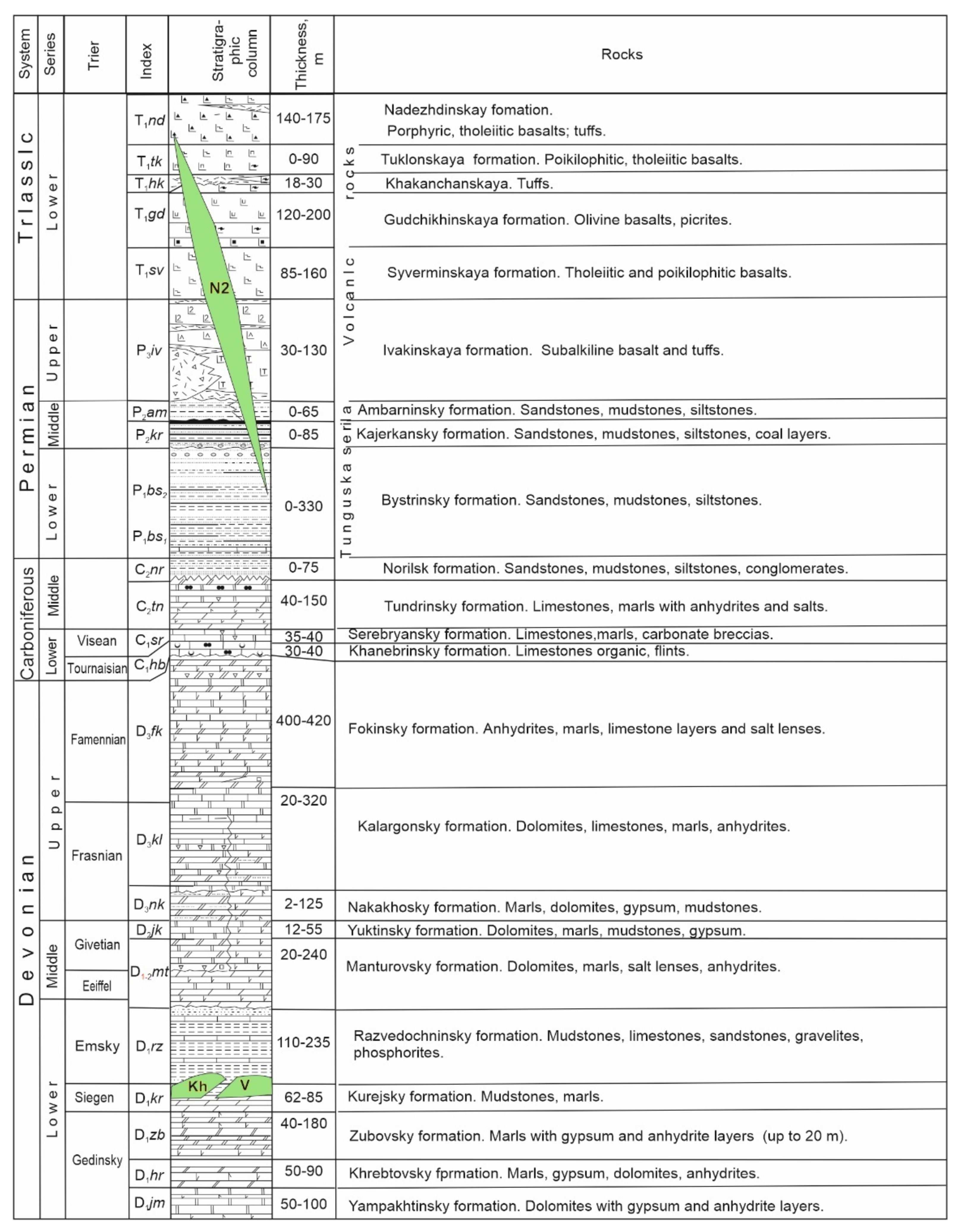
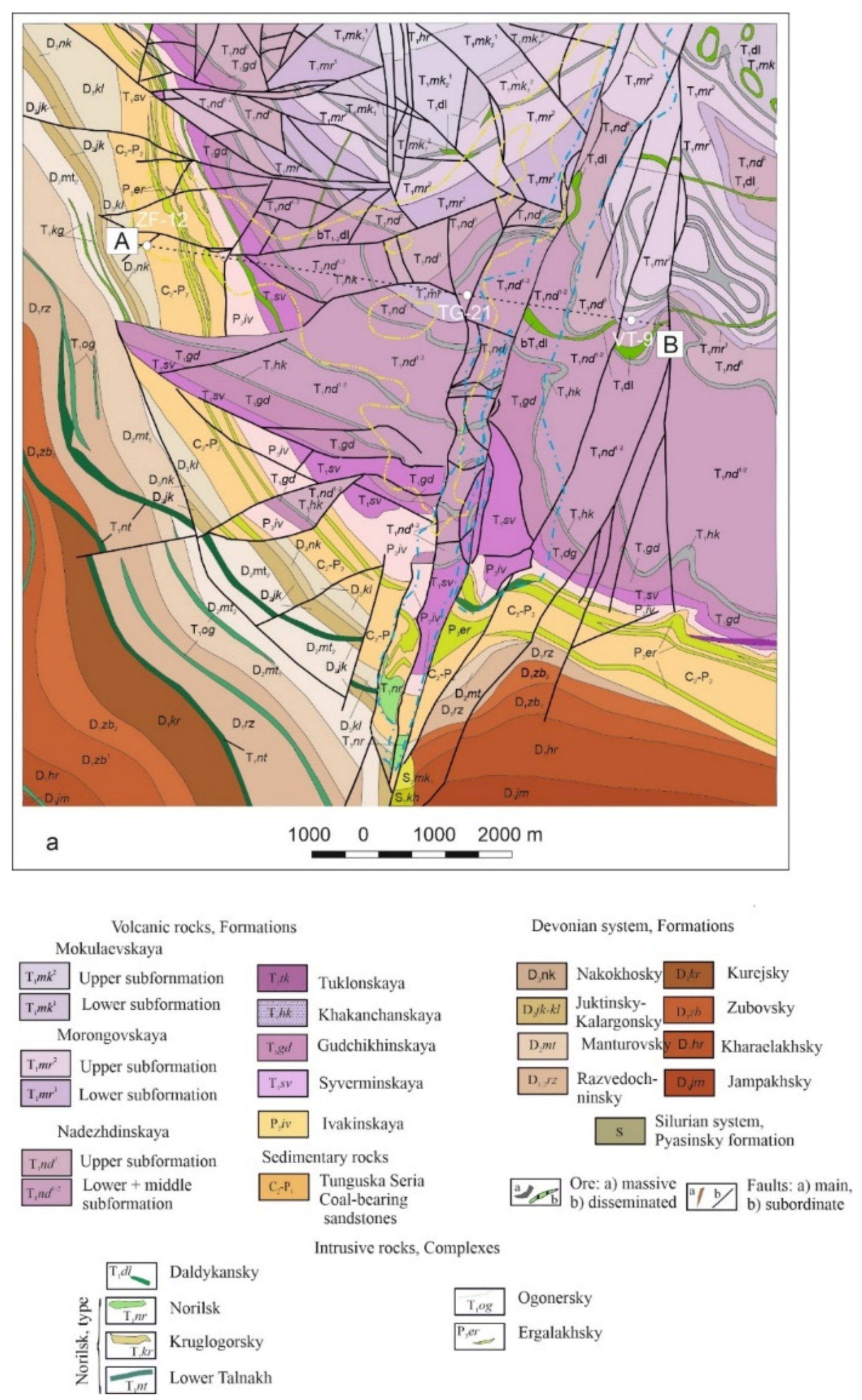

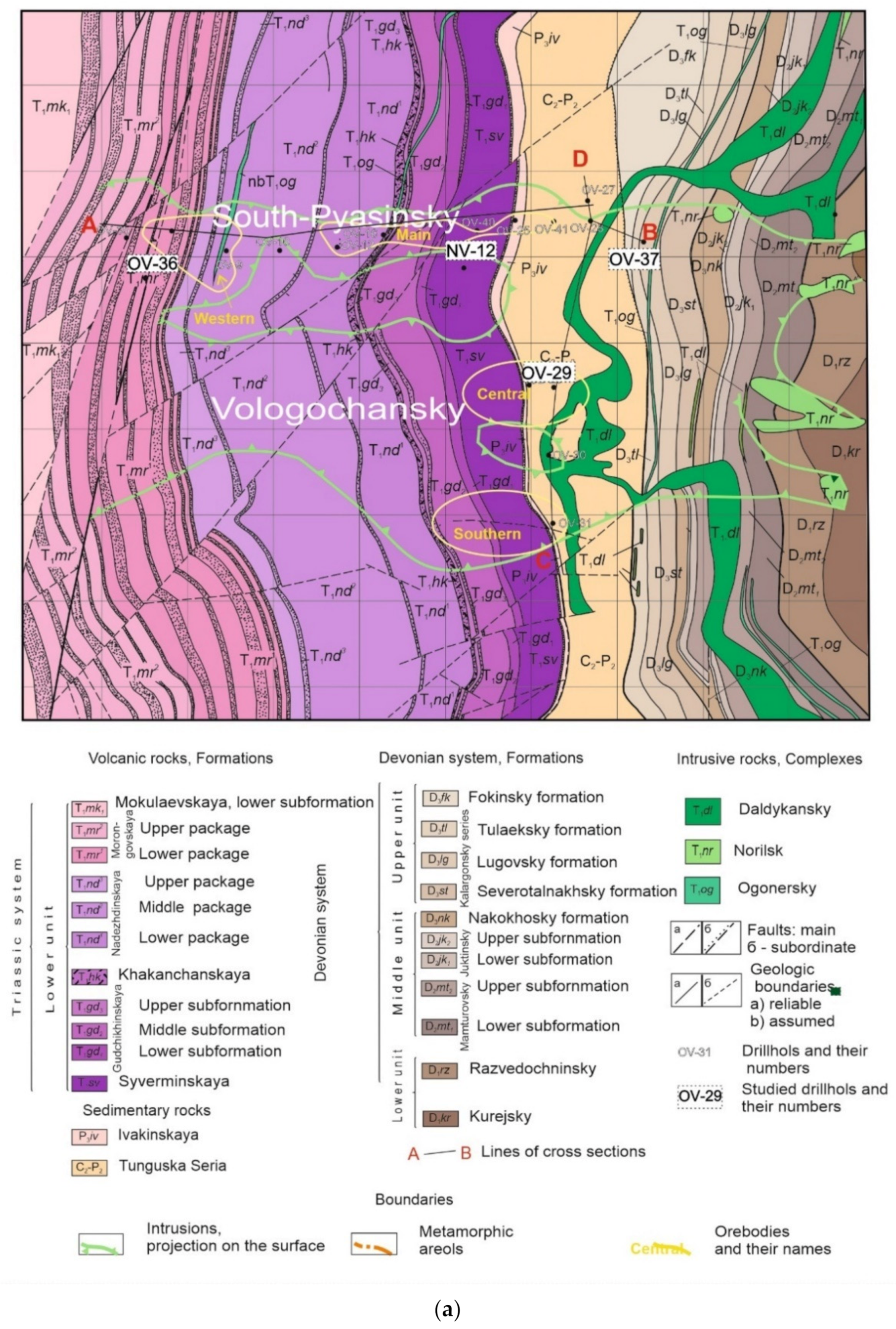
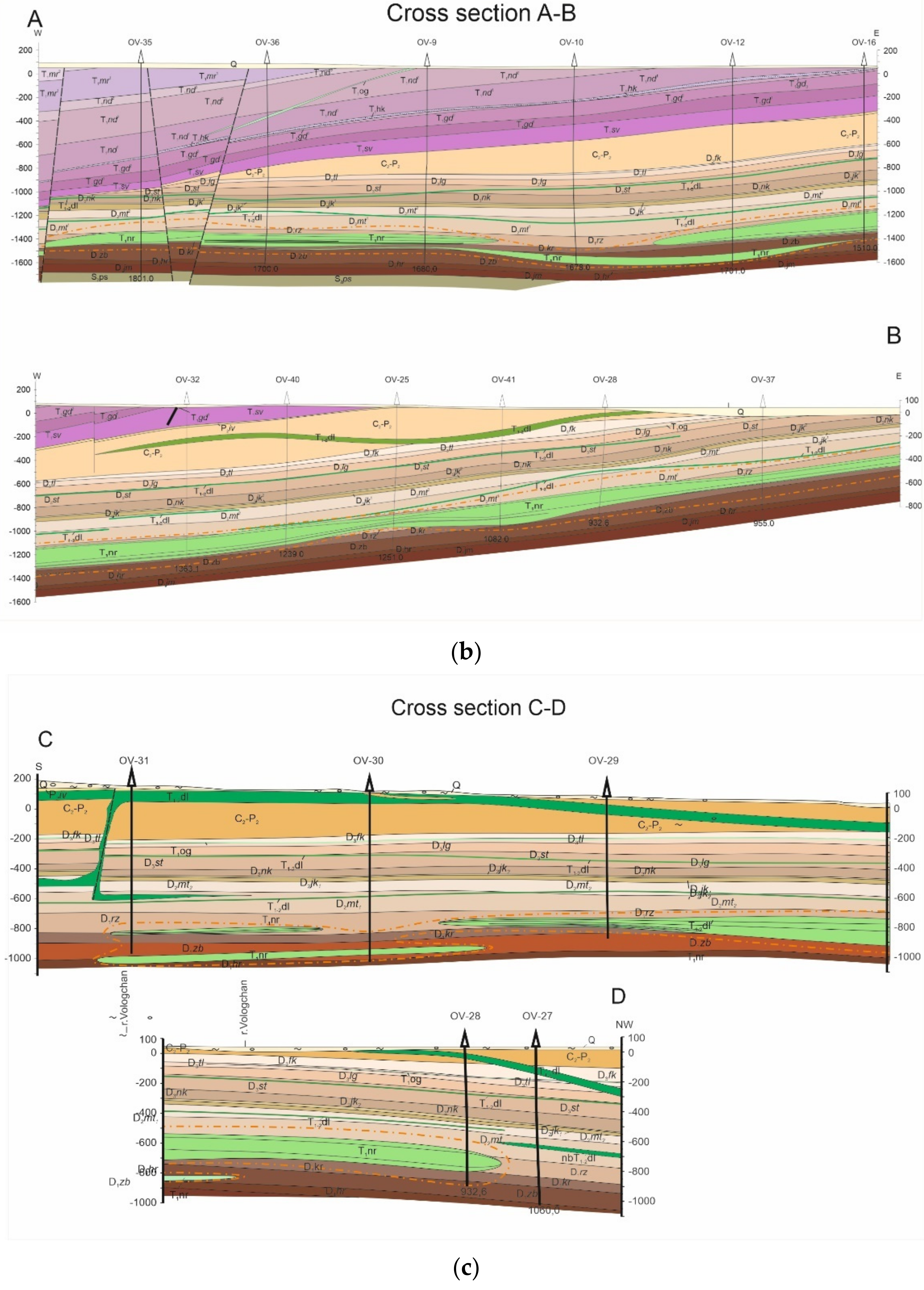
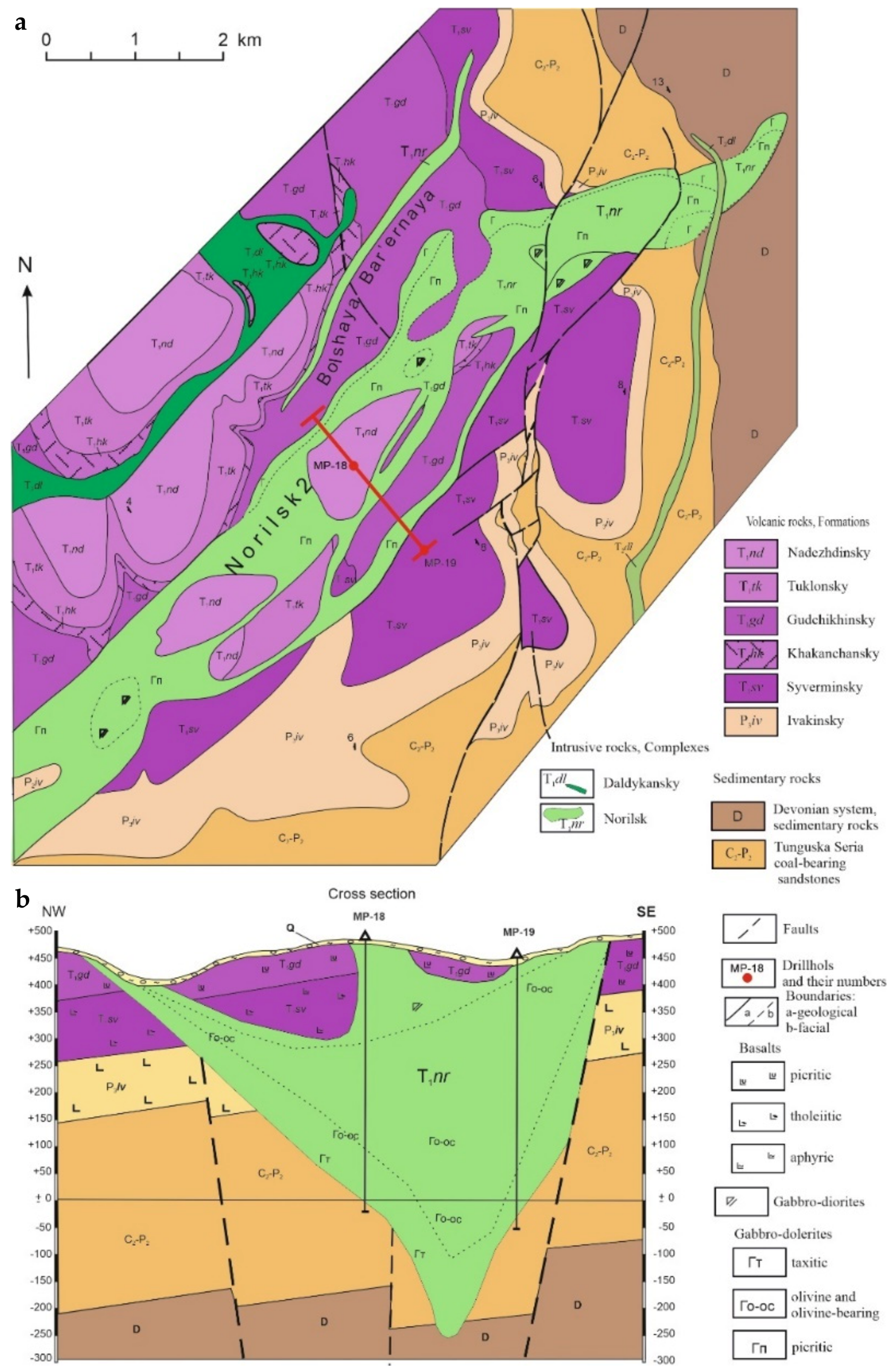
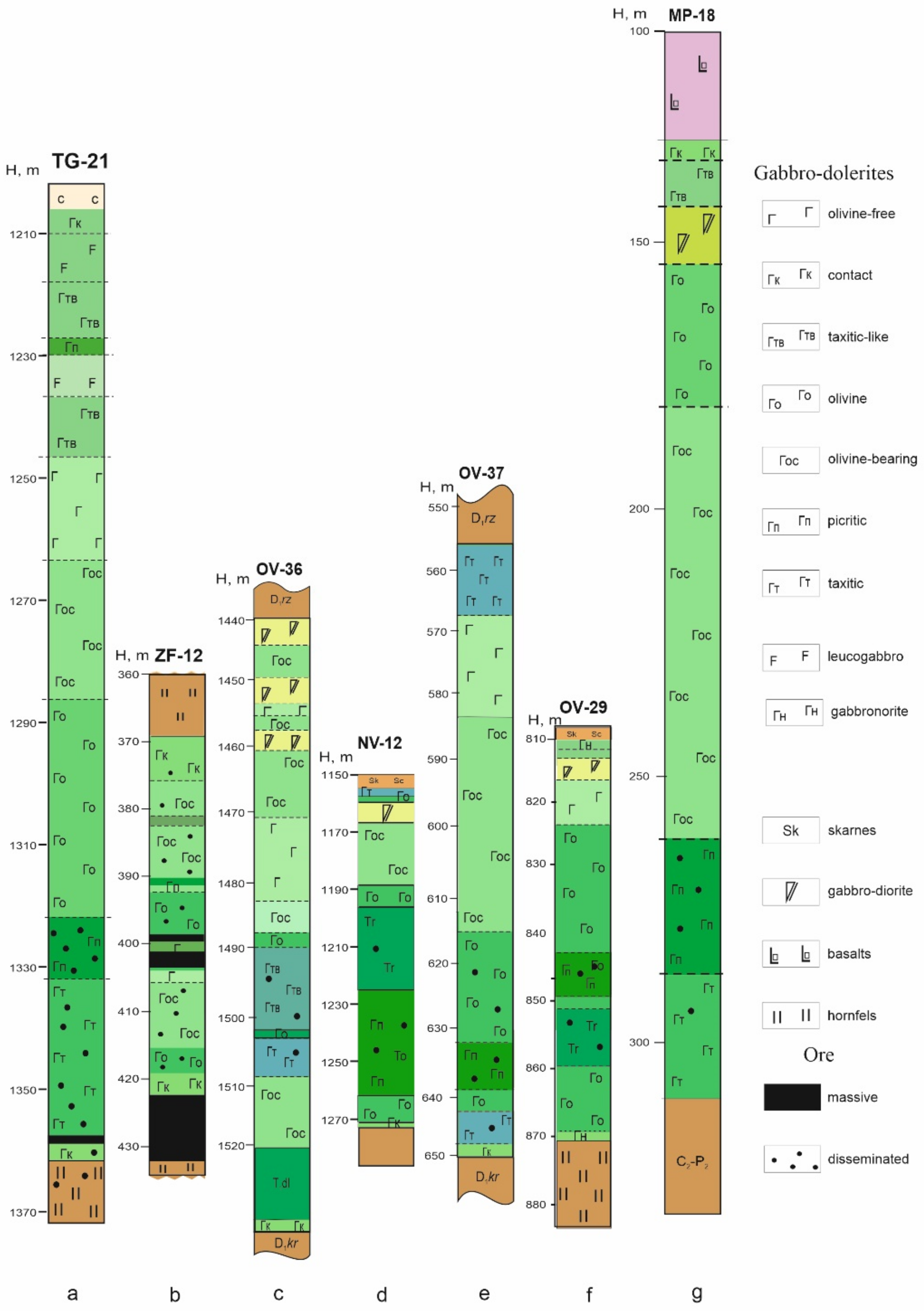



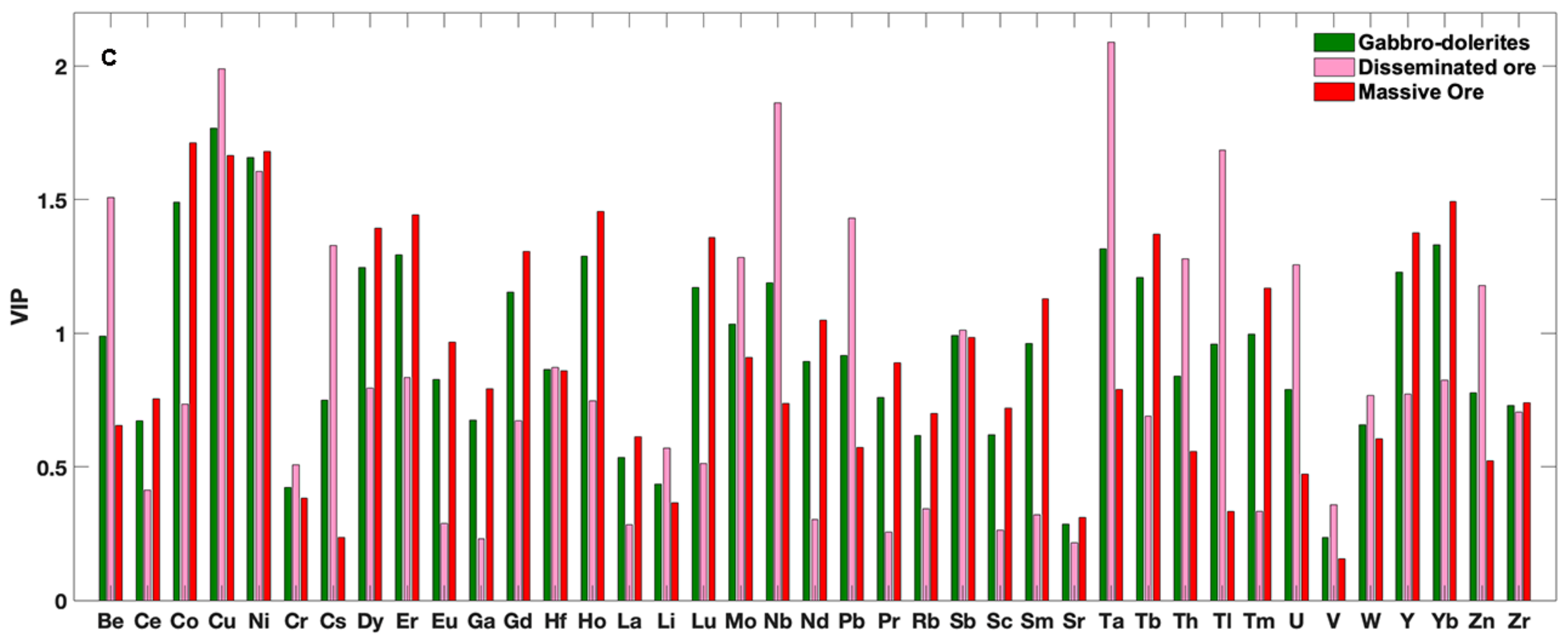

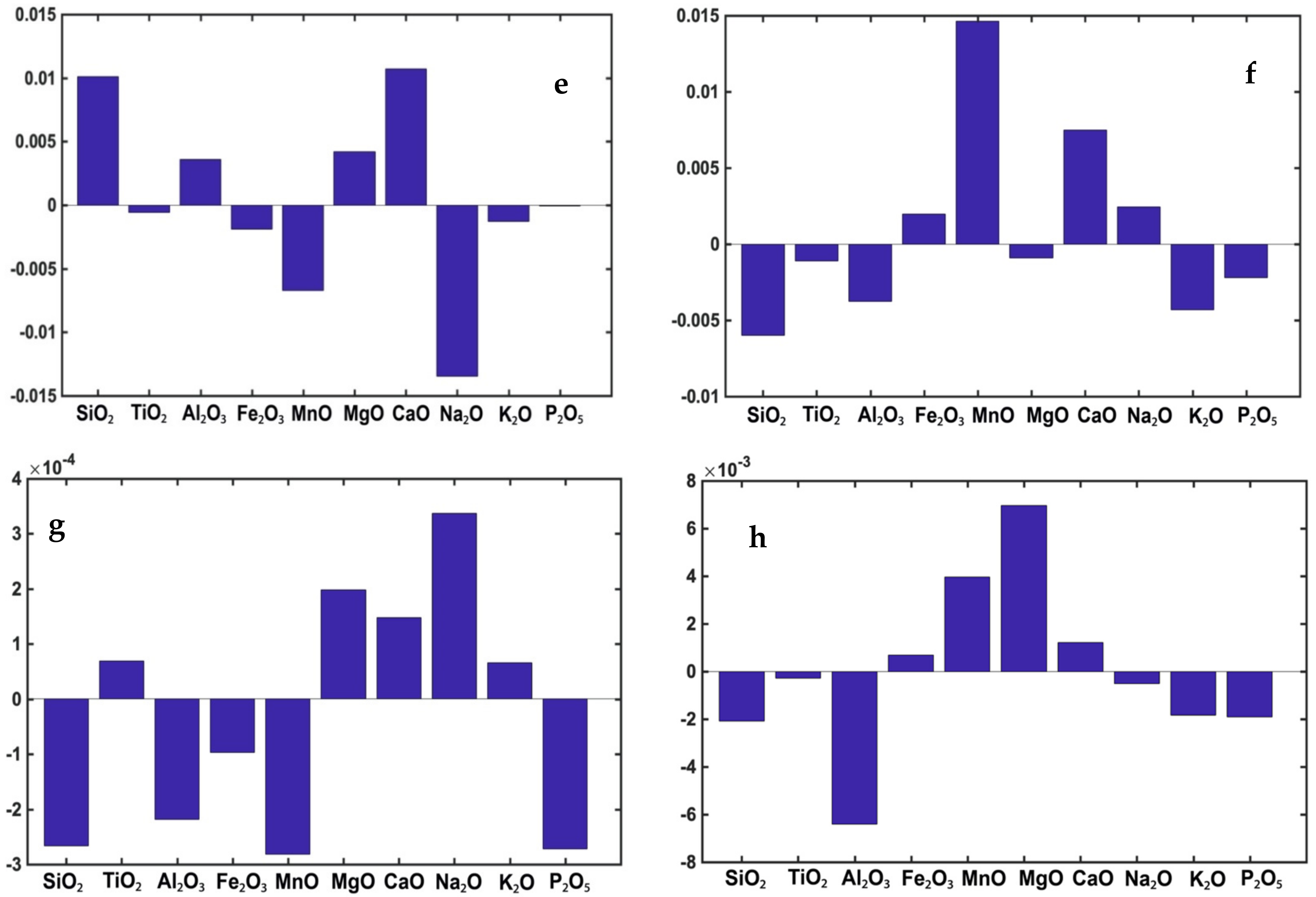
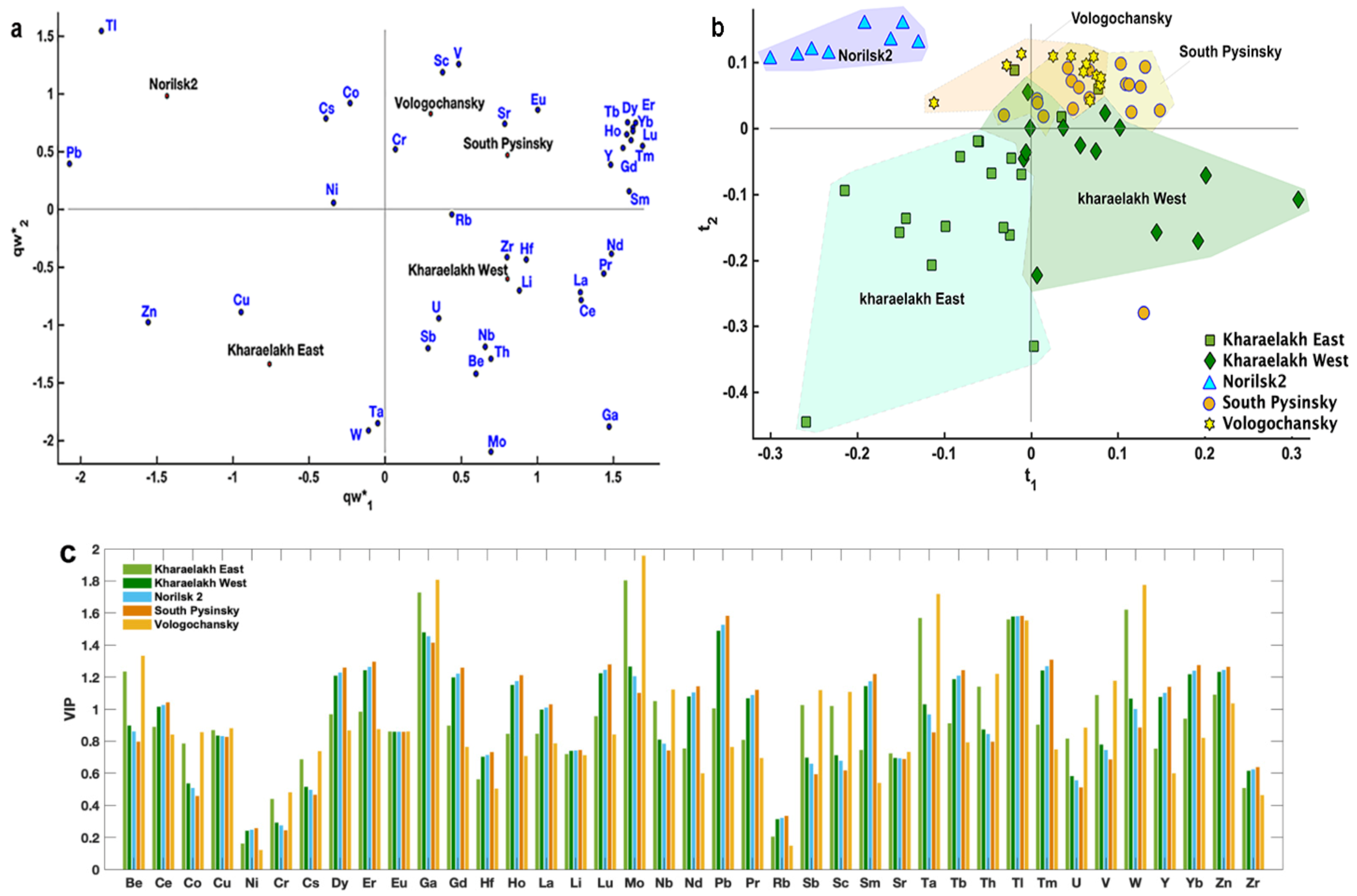


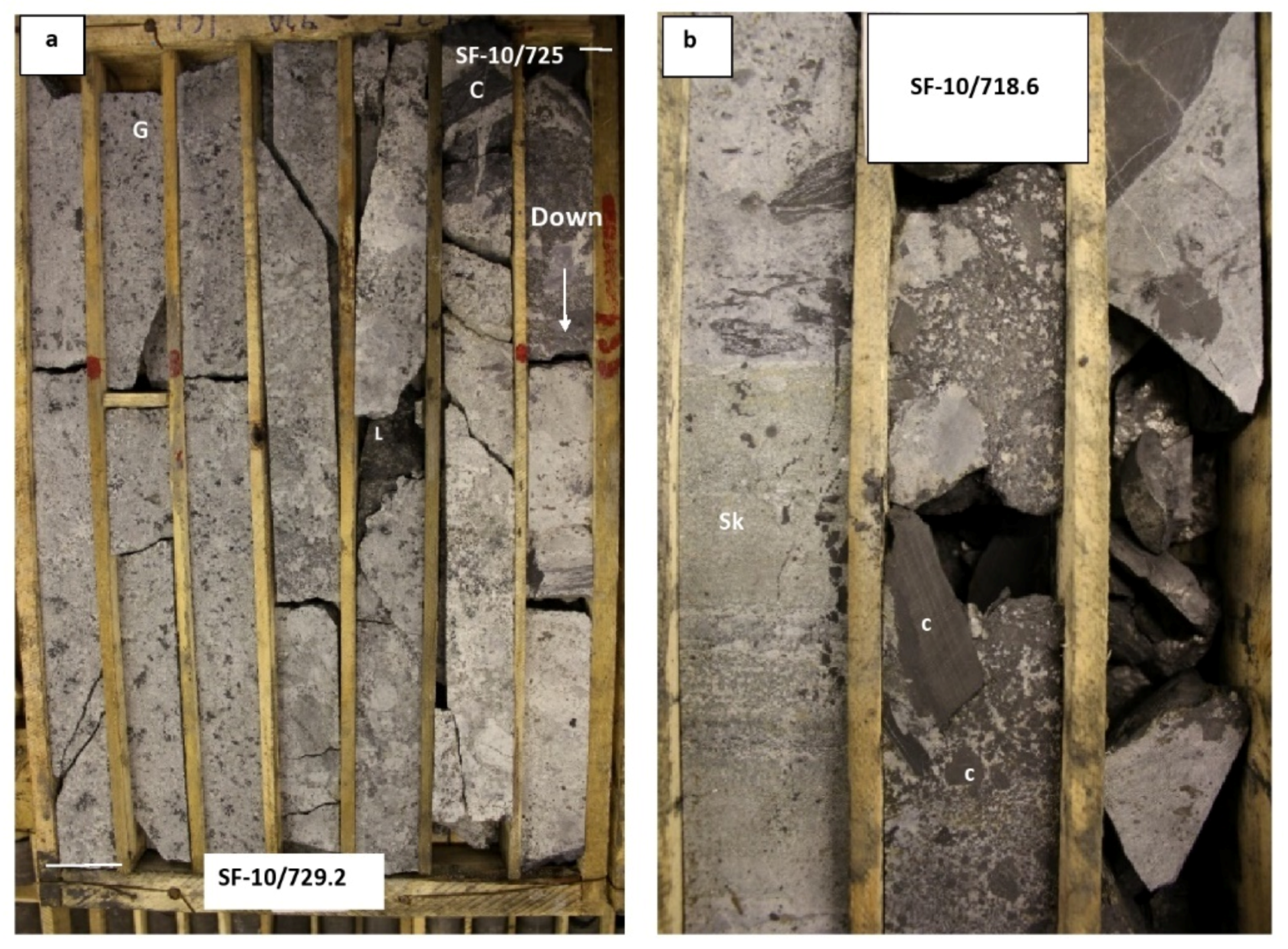
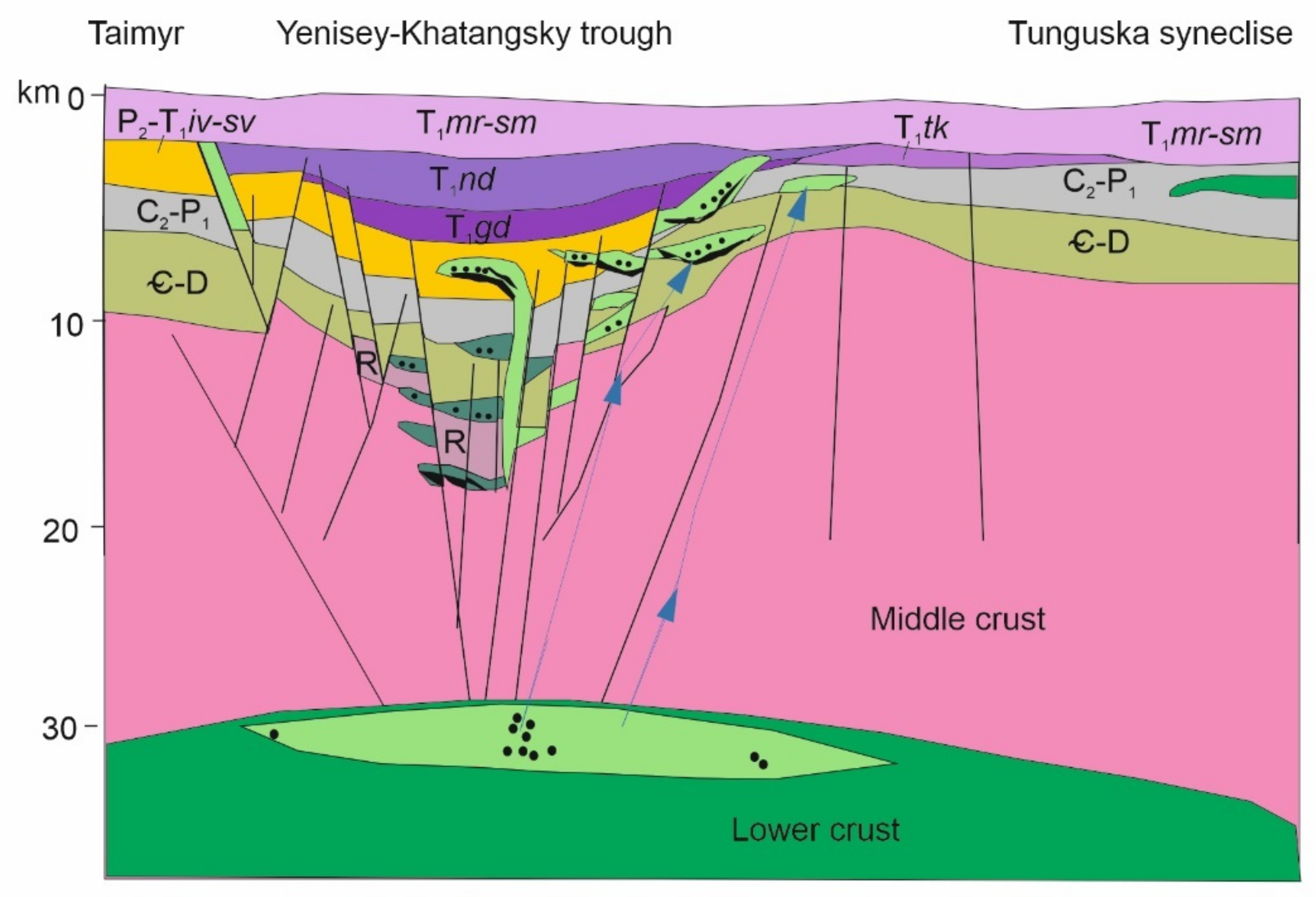
| Complex | Type | Rocks | Av. MgO, wt% | Massif | Deposit | Deposit Size |
|---|---|---|---|---|---|---|
| Daldykansky | - | dolerites | 7 | Daldykansky | - | - |
| Morongovsky | - | Picritic gabbro–dolerites-gabbro-diorites | 10 | Morongovsky Pegmatitivy | - | - |
| Ogonersky | - | - | 7 | Ogonersky | - | - |
| Norilsk | Zubovsky | - | 10 | Vologochansky, Pyasinsky | Vologochansky | L |
| Norilsk | Picritic gabbro–dolerites-gabbro-diorites | 10–12 | Kharaelakh, Talnakh, Norilsk 1 Maslovsky Norilsk 2 Mikchangdinsky Massif F-230 | Oktyabr’sky Talnakh Norilsk 1 Maslovsky Norilsk 2 Manturovsky | EL EL EL L S - | |
| Kruglo-gorsky | gabbro–dolerites-leucogabbro | 8–9 | Kruglogorsky | Bolshaya Bar’ernaya | S | |
| Lower-Talnakh | - | 14 | Lower Talnakh, Zelenaya Griva Mikchangdinsky | Lower Talnakh | M M ? | |
| Ergalakhsky | - | Trakhy-dolerites | 4–5 | Ergalakhsky | - | - |
| Intrusion | Kharaelakh East | Kharaelakh West | South-Pyasinsky | Vologochansky | Norilsk 2 | Chernogorsky | Talnakh | Norilsk 1 | ||
|---|---|---|---|---|---|---|---|---|---|---|
| Drillhole | TG-21 | ZF-12 | NV-12 | OV-37 | OV-36 | OV-29 | MP-18 | Ch-55 | 29 d.h. | 54 d.h. |
| No | 1 | 2 | 3 | 4 | 5 | 6 | 7 | 8 | 9 | 10 |
| SiO2 | 50.26 | 50.57 | 47.19 | 51.18 | 48.35 | 49.18 | 49.58 | 47.2 | 48.3 | 46.1 |
| TiO2 | 0.91 | 1.02 | 0.68 | 1.13 | 1.05 | 0.90 | 0.98 | 0.61 | 0.85 | 0.74 |
| Al2O3 | 17.32 | 15.83 | 15.63 | 17.26 | 13.13 | 14.95 | 15.76 | 16.7 | 15.33 | 15.5 |
| FeO | 10.89 | 7.35 | 10.47 | 9.53 | 9.57 | 10.92 | 10.49 | 9.91 | 12.3 | 13.4 |
| MnO | 0.18 | 0.19 | 0.18 | 0.18 | 0.20 | 0.21 | 0.29 | 0.16 | 0.19 | 0.15 |
| MgO | 7.93 | 9.47 | 12.72 | 6.87 | 15.13 | 11.66 | 8.65 | 11.64 | 10 | 11.3 |
| CaO | 9.49 | 12.13 | 10.30 | 10.98 | 8.93 | 9.64 | 11.66 | 11.4 | 10.4 | 10.3 |
| Na2O | 2.01 | 2.41 | 2.01 | 2.26 | 2.07 | 1.91 | 2.10 | 1.85 | 1.86 | 1.32 |
| K2O | 0.84 | 0.91 | 0.73 | 0.51 | 1.43 | 0.50 | 0.39 | 0.46 | 0.57 | 0.69 |
| P2O5 | 0.18 | 0.12 | 0.09 | 0.10 | 0.15 | 0.12 | 0.11 | 0.07 | 0.2 | 0.25 |
| Cr | 1058 | 1841 | 277 | 305 | 686 | 578 | 336 | 1800 | 1000 | 1900 |
Publisher’s Note: MDPI stays neutral with regard to jurisdictional claims in published maps and institutional affiliations. |
© 2021 by the authors. Licensee MDPI, Basel, Switzerland. This article is an open access article distributed under the terms and conditions of the Creative Commons Attribution (CC BY) license (https://creativecommons.org/licenses/by/4.0/).
Share and Cite
Krivolutskaya, N.; Makvandi, S.; Gongalsky, B.; Kubrakova, I.; Svirskaya, N. Chemical Characteristics of Ore-Bearing Intrusions and the Origin of PGE–Cu–Ni Mineralization in the Norilsk Area. Minerals 2021, 11, 819. https://doi.org/10.3390/min11080819
Krivolutskaya N, Makvandi S, Gongalsky B, Kubrakova I, Svirskaya N. Chemical Characteristics of Ore-Bearing Intrusions and the Origin of PGE–Cu–Ni Mineralization in the Norilsk Area. Minerals. 2021; 11(8):819. https://doi.org/10.3390/min11080819
Chicago/Turabian StyleKrivolutskaya, Nadezhda, Sheida Makvandi, Bronislav Gongalsky, Irina Kubrakova, and Natalia Svirskaya. 2021. "Chemical Characteristics of Ore-Bearing Intrusions and the Origin of PGE–Cu–Ni Mineralization in the Norilsk Area" Minerals 11, no. 8: 819. https://doi.org/10.3390/min11080819
APA StyleKrivolutskaya, N., Makvandi, S., Gongalsky, B., Kubrakova, I., & Svirskaya, N. (2021). Chemical Characteristics of Ore-Bearing Intrusions and the Origin of PGE–Cu–Ni Mineralization in the Norilsk Area. Minerals, 11(8), 819. https://doi.org/10.3390/min11080819








